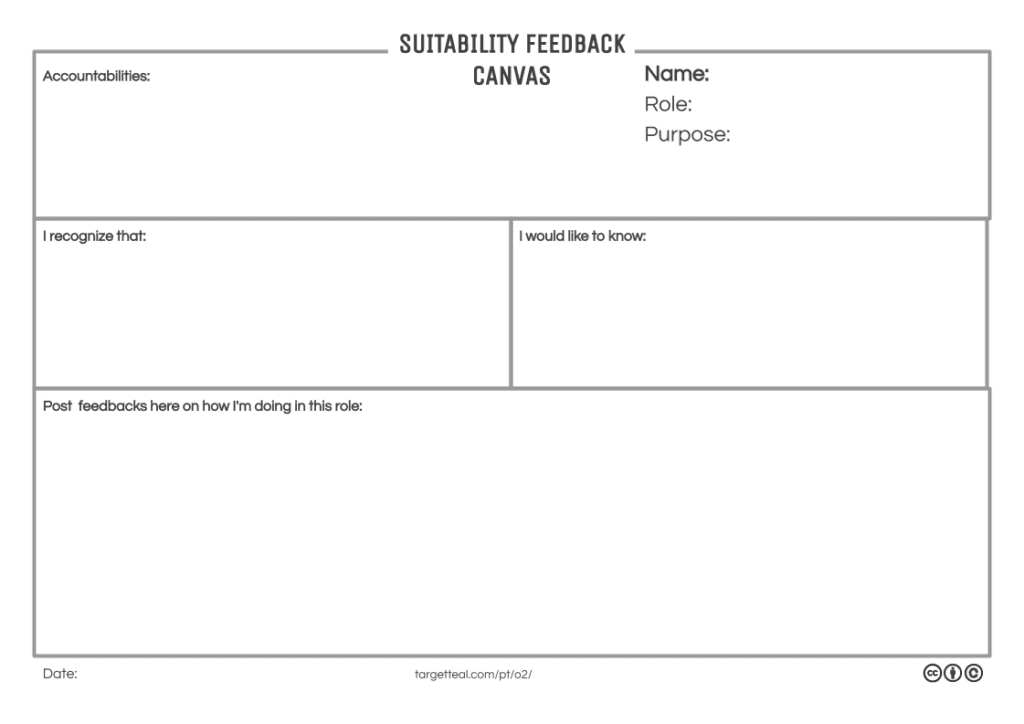The issue of feedback raises discomfort and even trauma in most people who have experienced such a practise in a corporate environment.
In a process of transition to self-management using O2, the topic still generates great anxiety at the beginning, as the traditional figure of the people manager is called into question. “Who will give me feedback?” some people ask.
If you still haven’t heard about O2 social technology and how it can help you to adopt self-management practices, check it out here.
Even though the meta-agreements state that it is the External Link’s responsibility to provide feedback to improve a person’s suitability in a role, it is still confusing to many what this actually means. And (thankfully) this suitability feedback is not quite the feedback people are used to getting.
To alleviate this tension we first need to clarify what I see as two distinct types of feedback within O2.
Suitability feedback
As person X, plays the role Y, that is:
- How does she carry out the accountability of that role
- If she acts beyond the accountability described, seeking the purpose
- How can she improve her performance in that role
Feedback between people
How does person X feel when working with person Z and vice versa, ie:
- What is the impact of the actions of X on Z and vice versa
- What feelings does X have about Z’s actions and vice versa
- How X and Z can communicate in ways that strengthen bonds of trust and tribal space
Note that the first example of feedback mainly deals with themes pertaining to Organizational Space, while the second deals with Tribal Space issues. When we separate the two, we can apply different strategies and this allows us to honor the organizational purpose and human relationships present there. The cost is too high when we neglect one for the other.
Changing suitability feedback
Let’s say your organization follows the same version of the meta-agreements, where each circle has an External Link and it is assigned to allocate people to roles and give feedback on suitability. However, as we know, an accountability does not limit the actions of other people. Therefore, everyone can give suitability feedback. The question that sometimes remains is that there is no such thing as a habit.
It can be very important to provide opportunities for everyone to exchange feedback, that’s why I was inspired by Matheus Haddad’s Feedback Canvas and created another one, specific to suitability feedback.
The flow of the session begins with an explanation of what this type of feedback would be and handing in a Suitability Feedback canvas sheet for each role people take. So, if so-and-so plays 4 roles in that circle, he gets 4 sheets. Here is a layout that can be used:

After that, the facilitator gives the following instruction:
- Fill in one canvas for each role (30min)
- Stick your each sheets to the wall
- Write feedback on post its and stick onto colleagues’ sheets (30min)
- Classify the feedbacks received as Acknowledged (grade from 1 to 5) and Important (grade from 1 to 5) (5min)
- Take one last look at all the sheets you left feedback on (10min)
- Do not settle for this session, continue seeking feedback, or seek clarification outside of the session.
Note that there may be a specific type of feedback here that is actually the manifestation of an implicit expectation. For example, there is an Infrastructure role for the site, and it does not contain an accountability that says: “Do regular back-ups of the site.”. In this context, giving feedback such as “You could have done back-ups, to avoid the problems we had” would be an implicit expectation that could be better resolved in Adapt mode, with the proposal of a new accountability.
Another important thing to note is that in Suitability Feedback it is much easier to follow the principles of good feedback: specific, objective, actionable, and solicited. These same principles are more difficult to apply in the second type, feedback between people.
Exchanging feedback between people
Funny, all feedback is between people. I chose this name to reinforce that there is a subjective and complex human relationship here. And we can’t summarize this conversation in a form, post-it notes, let alone a 3×3 matrix. ;)
Here the focus is to strengthen the relational space, through one-on-one conversations. We are no longer interested in suitability feedback, but about how one feels about the other’s actions.
Davi’s advice in his text about feedback fits perfectly here:
“You can only change yourself.
Perhaps you can provide information and make requests that impact others.
But if that doesn’t work, focus on you.
After all, when you want to give feedback, it’s not about the other person. It’s about your needs.”
We’re looking to create a space for people to have deep and sometimes difficult conversations, so it’s important to look at how people are familiar with non-violent communication (CNV) practices and principles.
If you are in one or several circles and would like to promote a specific moment of feedback between people, you can propose a session with the very simple instructions, listed below:
- If you are sitting together with a colleague, then you are exchanging feedback.
- If you are standing then you are either waiting to be called or waiting for someone to call you to exchange feedback.
- Make the best use of these 90 minutes.
It is worth reminding people to take advantage of this moment to celebrate the quality of relationships, trust and the generosity of people. We don’t only want to have difficult conversations, but pleasurable ones as well.
Regular practice of one-on-one conversations with CNV principles can go a long way in maintaining a healthy tribal space.
AND THE OTHER THINGS LINKED TO FEEDBACK?
It is always good to reinforce the purpose of each proposed practice and concept. The suggestions I put here are not intended to create a mechanism to define salaries, variable remuneration, etc. I wrote another text about it here.
My intention was just to strengthen the practice of exchanging feedback within an organization that is practicing O2 and to restore confidence so that we can help one another on our development journey.
For me, this is something really amazing and sometimes may even be enough.
If you want help changing the feedback culture within your organization, you can count on Target Teal. Let’s have a coffee?
Translated by Tanya Stergiou






Leave A Comment